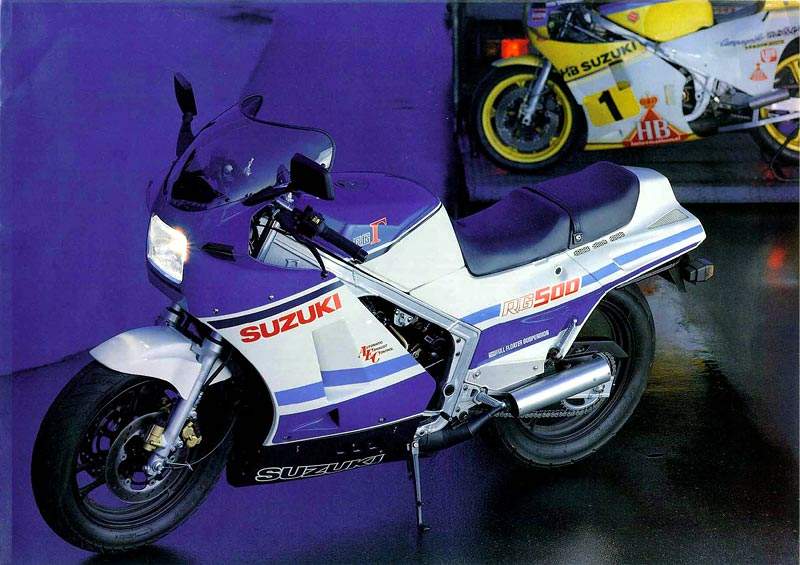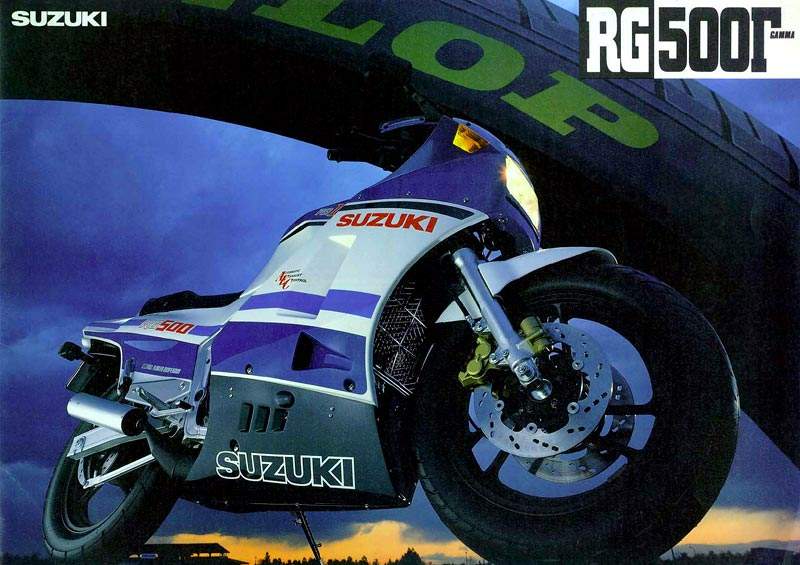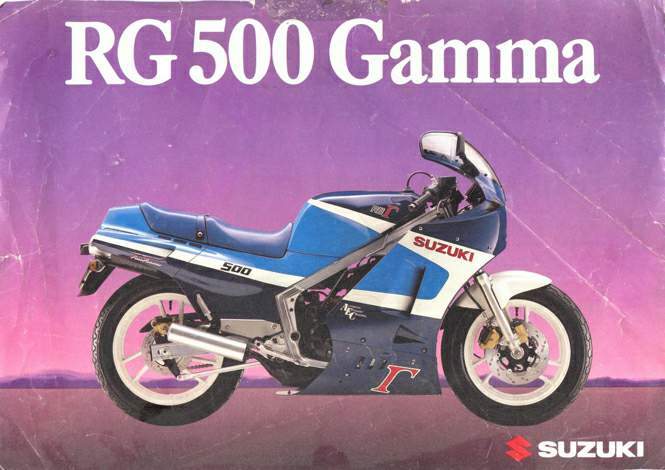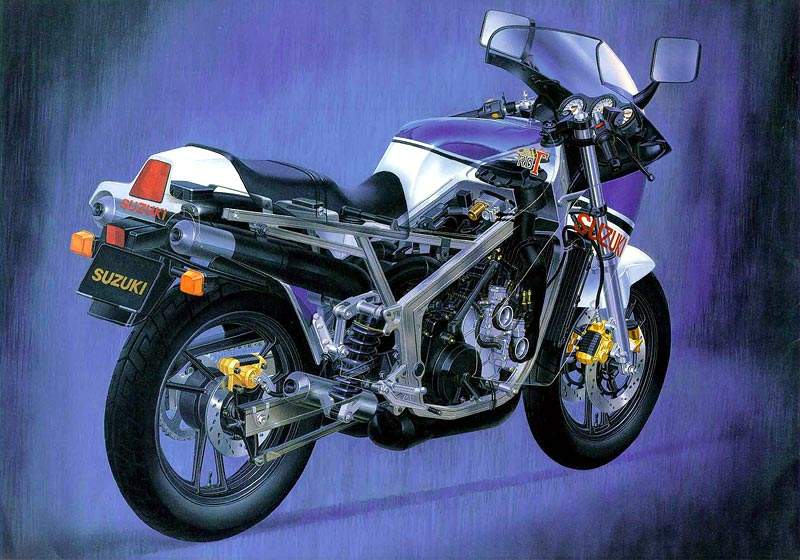
|
|
|
|
|
|
Classic Bikes
Custom Bikes
Individual
Racing Bikes AJP
AJS
Aprilia
Ariel
Avinton / Wakan
Bajaj
Benelli
Beta
Bimota
BMW
Brough Superior
BRP Cam-Am
BSA
Buell / EBR
Bultaco
Cagiva
Campagna
CCM
CF Moto
Combat Motors
Derbi
Deus
Ducati
Excelsior
GASGAS
Ghezzi Brian
Gilera
GIMA
Harley Davidson
Hero
Highland
Honda
Horex
Husaberg
Husqvarna
Hyosung
Indian
Jawa
Kawasaki
KTM
KYMCO
Laverda
Lazareth
Magni
Maico
Mash
Matchless
Mondial
Moto Guzzi
Moto Morini
MV Agusta
MZ / MuZ
NCR
Norton
NSU
Paton
Peugeot
Piaggio
Revival Cycles
Roland Sands
Royal Enfield
Sachs
Sherco
Sunbeam
Suzuki
SWM
SYM
Triumph
TVS
Ural
Velocette
Vespa
Victory
Vincent
VOR
Voxan
Vyrus
Walt Siegl
Walz
Wrenchmonkees
Wunderlich
XTR / Radical
Yamaha
Zero
Video
Technical
Complete Manufacturer List
|
Suzuki RG 500 Gamma
|
| . |
| Make Model | Suzuki RG 500 Gamma |
| Year | 1985 |
| Engine | Two stroke, square four cylinder, rotary valve with exhaust port valves |
| Capacity | 498 cc / 30.4 cu in |
| Bore x Stroke | 56 x 50.6 mm |
| Cooling System | Liquid cooled |
| Compression Ratio | 7.0:1 |
| Lubrication | Wet sump |
| Induction | 4 x 28mm Mikuni VM28SH Flatslide carburetors |
| Ignition | Suzuki PEI |
| Spark Plug | NGK, BR9ES |
| Starting | Kick |
| Max Power | 70 kW / 95 hp @ 9000 rpm |
| Max Power Rear Tyre | 61.9 kW / 83 hp @ 10000 rpm |
| Max Torque | 72 Nm / 7.3 kgf-m 53.1 lb-ft @ 9000 rpm |
| Clutch | Wet, cable operated |
| Transmission | 6 Speed |
| Final Drive | Chain, 2.500 (40/16) |
| Primary Drive Ratio | 2.230 (58/26) |
| Gear Ratio | 1st 2.636 (29/11) / 2nd 1.750 (28/16) / 3th 1.380 (29/21) / 4th 1.173 (27/23) / 5th 1.045 (23/22) / 6th 0.956 (22/23) |
| Frame | Steel, double cradle frame |
| Front Suspension | Air adjustable fork with 38mm tubes, adjustable spring preload and anti dive valuing. |
| Front Wheel Travel | 130 mm / 5.2 in |
| Rear Suspension | Shock absorber, adjustable for spring preload |
| Rear Wheel Travel | 126 mm / 4.9 in |
| Front Brakes | 2 x 260 mm Discs, 4 piston calipers |
| Rear Brakes | Single 210 mm disc, 2 piston caliper |
| Front Tyre | 110/90 V16 |
| Rear Tyre | 120/90 V17 |
| Dimensions |
Length 2100 mm / 82.7 in Width 695 mm / 27.4 in Height 1185 mm / 46.7 in |
| Wheelbase | 1425 mm / 56.1 in |
| Seat Height | 770 mm / 30.3 in |
| Ground Clearance | 120 mm / 4.7 in |
| Dry Weight | 156 kg / 339.5 lbs |
| Wet weight | 175 kg / 386 lbs |
| Fuel Capacity | 22 Litres / 5.8 US gal / 4.8 Imp gal |
| Consumption Average | 8.7 L/100 km / 11.5 km/l / 27 US mpg / 32.5 Imp mpg |
| Braking 60 km/h - 0 | 16 m / 52.5 ft |
| Braking 100 km/h - 0 | 39.2 m / 18.6 ft |
| Standing ¼ Mile | 11.2 sec / 193.9 km/h / 120.5 mph |
| Top Speed | 236.4 km/h / 146.9 mph |
| Road Test | Motociclismo |
| . |
Suzuki have been developing and refining a square four, two-stroke motorcycle for years. Since 1976 they have had at least one new model for every year but none of them was for sale. They were the exclusive property of the paid factory riders and were all works race bikes.
Barry Sheene won the 1976 and 1977 500cc World Championships on an RG500. So did Marco Lucchinelli in 1981 and Franco Uncini in 1982. At the highest level of competition, the blue riband 500cc Grand Prix, Suzuki's RG has always been a fierce and formidable contender. In 1985, Suzuki unveiled a stunning, spellbinding RG500 Gamma for the road. One might describe it as an authentic racer with lights.
The race replica wars have certainly come a long way: replicas are now arguably as fast as some of the original racers on which they are based. Like the racing Gamma's, the street-legal RG is a liquid-cooled, twin crank, square four with disc valve induction. Fed by four ultra-thin, 28mm flat slide Mikuni carburettors located on the outside of each cylinder, and with the gas helped by Suzuki's intake power chamber on the way in and their power valve on the way out, the Gamma revs way beyond the redline and makes power in huge peaks of blistering stomp.

There is little below 6,000rpm but it revs hard and fast to 9,000 where it starts falling away but then at 9,500rpm it is suddenly back on the pipe and bang, it revs wildly and is making horsepower up to 12,000rpm. Acceleration is mind-bending. Whacking open the throttle has those four tiny, delicate carburettors dancing at the end of their cables and cracking instantly into life. Run flat out through six well-spaced gears, it is still accelerating at 135mph and 9,500rpm in top.
Despite its peaky rev-craziness, the engine is not animal-like in behaviour and response. It is possible to drop below 6,000rpm without it dying or oiling up the plugs. The power is progressive and fairly smooth for a two-stroke. At 340 lb the Gamma is remarkably light for its size but it is also fairly tall. The alloy double cradle frame and full floater monoshock suspension do a fine job of keeping the wheels on the ground. The steering is not just quick but fast. It needs a positive, deliberate riding style but the reward is razor-sharp handling and beautiful roadholding. In order to reduce speed quickly the bike has very powerful brakes - twin 260mm front discs with four pot calipers that used hard will tear the rubber off the 16in front tyre.
The release of the RG500 poses an
interesting question. Mechanically, the bike is very closely related to the
legendary RG racer. Would a suitably prepared version of the road bike have
been capable of winning a 500cc GP race in the late 1970s? Who knows? The
detail work on the RG is of such a high and exotic standard that it can only
have been learnt from Suzuki's many years of developing and campaigning
their factory racers. That is over ten years of racing secrets made
available for the road. Blessed with an immaculate pedigree and a reputation
forged on the racetracks of the world, the Gamma is an extremely fast and
mighty projectile. Excitement guaranteed.
Review In 1984, a Yamaha advert quite boldly stated “ No one has
ever built a road machine so close in technical basis to a
current GP winner. Quite frankly we do not expect that any one
else ever will”. How wrong they were and just one year later they had good
cause to regret that statement as the Suzuki RG500 burst onto
the scene. Thankfully Suzuki were brave enough to give us not
only the visual image, but also a real taste of GP performance
with the Gamma. Endowing the machine with plenty of fire from
within its four-pot belly, rather than the somewhat castrated,
and over weight effort that Yamaha made with the RD500. Place the RD500, NS400 and RG500 Gamma side-by-side and you
would have three of the top manufacturers attempts at producing
a replica of their respective GP racers, however, with all but
one of those machines, all you purchased was a mere shadow of
the original design. That is not to say the others were rubbish,
far from it in fact, but the RG was definitely nearer the mark,
and actually far closer to the race machine than you might ever
imagine. The Suzuki is almost an exact replica of the race machine,
its roots can be traced directly to the 1983 factory XR45 and
the crankcases, barrels and general engine layout are virtually
identical to the bikes ridden by Sheene, Mamola, Crosby and the
rest of the factory boys. The bore and stroke is identical in design to the race
machine, as indeed are most of the engine components although a
shock damper was added to the lay shaft to reduce loads between
the cranks and the clutch/ gearbox. Starting the engine is
achieved by kick-starter and, unusually for a Japanese machine,
as the mechanism does not drive the clutch outer gear, but the
input shaft of the gear box, the engine has to be started in
neutral rather than simply leaving it in first and holding the
clutch in. The engine breathes through four flat-slide Mikuni VM28SH,
mounted like the racer in pairs either side of the engine. When
viewed from the side these carburettors are incredibly short,
only 36mm, and is key to good power from a disc-valve engine.
Just like the real racer the gearbox is a cassette type and can
be removed in double quick time giving access to the gear wheels
enabling different ratios to be fitted for all of the gears. The
factory race bikes of 83/84 could utilise up to six different
ratio’s for the first four gears and five for fifth and sixth
and this feature was retained for the roadster. The ratios
chosen for the roadster gearbox are, apart from the ridiculously
high first gear, pretty well matched for high-speed use,
although the five locating dogs on each pinion do slow down the
selecting mechanism somewhat. It would be reasonable to assume that, although no race kit
was announced or in fact produced by Suzuki at the launch of the
Gamma, it was obviously originally designed to accept go faster
goodies, thus creating a formidable production class race bike.
A theory suggested by Graham Dyson, whose UK based company, Nova
designed and built a race gearbox for the RG, was that the Gamma
was so close to the RG, the factory correctly assessed that a
race kit would detract sales from the real thing by providing a
much cheaper yet still competitive alternative.
All this power was managed by the Suzuki Automatic exhaust
control (SAEC), which utilised a servo power gate that opened up
a chamber in each barrel/ head assembly increasing the volume of
the exhaust down pipe. The SAEC valve is controlled by the AEC
box, fed by signals from the CDI box, then via a stepper motor
and cables to the valves. These rotary valves only actuated
below 7500rpm by which time they would be fully opened up. This
was Suzuki’s variation on the YPVS exhaust valve, and Honda’s
ATAC system. The SAEC gave the Gamma an impressive spread of
power with good pull available from 5000revs with things getting
really serious at 7000 before shooting completely through the
10,000 redline to a worrying, but non the less fantastically
exciting, 12k According to the Suzuki published power curves
there is no actual increase in power above 9500rpm, but it
certainly does not feel like that when riding the RG. Exactly like the race machine, the four water-cooled
cylinders are arranged in a square above two stepped
crankshafts, with the pistons set at 180 degrees to each other
so that they fire in opposite pairs, giving perfect mechanical
balance. So smooth is the running of the Gamma that, unlike the
50-degree V-four layout of the Yamaha 500LC, no power sapping
balance shafts are required to dampen out vibration, saving much
weight and space in the process. The RD will lose something like
8bhp just because of the balance shafts. Power is plentiful and with a little fettling can be improved
enormously. Mildly tuned machines have recorded as much as
108bhp and 55ft lbs of torque. A common mod is the fitting of
aftermarket pipes and these can, with a little rejetting,
instantly transform your machine. The main reason for this is
the original manufacturer has to comply to various limiting
noise regulations at certain engine revolutions whereas the
after market guy doesn’t. Total weight for the Gamma was a rather portly 154kgs, but
this is due to the equipment required to make it road legal,
with this removed the weight soon drops to a more competitive
130kgs. Surprisingly in standard form the Gamma is actually 9kgs
lighter than the Honda NS400R. The aluminium square section
frame, constructed along the same lines as the GSXR 750 but with
a much heftier steering head, held everything nicely in place
and gave a very precise ride, the massive steering head doubles
up as the entrance to the six-litre air box and filter housing. The handling is very good particularly on a track although
the sixteen inch front wheel sometimes makes the RG a little
frisky when on the bumpy, pot hole ridden, queens highway. By
today’s standards the tyres, 110/90V 16” front and 120/90V 17”
rear are skinny but back then this was the very forefront of
chassis design. The front forks where the usual telescopic oil
damped units with spring pre load adjustment, air valves and the
dreaded “anti dive” mechanism, although this one worked
reasonably well, located on the front of each fork slider. The
rear “Full-floater” suspension system, operated by a rocker arm
assembly, was adjustable via a remote knob. For such an agile
machine the head angle is a lazy 30deg, with a largish trail of
110mm too. Two 260mm floating discs grabbed by a pair of 4 pot
calipers, identical to the GSXR750 of the time, providing the
stopping power, with a much smaller rear disc and basic caliper
performing the duties at the rear.
In 1986 Padgett’s of Batley began development of a Gamma
based TTF1 machine. Having already experimented with the
overweight Yamaha, Padgett’s turned their thinking to the Gamma
as a potential contender. The F1 rules of the time allowed
1000cc four stroke and 500cc two stroke road based machines, and
from the very beginning of development the Padgett’s RG Gamma
was competitive, producing power and speed not far off the
performance of the real thing. At Hockenheim, that season, the
Gamma passed the speed trap at 171mph while the pukka race RG
clocked 173mph, a mere 2mph difference. Lincoln rider, Mark Phillips convincingly won the Shell Oils
TT F1 championship in 1986 on the Padgett’s Gamma amongst a sea
of FZ750 Yams and GSXR Suzuki’s. Mark remembers “The F1 bike was
something very special indeed, actually lighter than the MK10 RG
I was racing in the open classes. At Assen, after fitting a race
ignition, I had to keep backing off the throttle because it was
revving so high I thought it would blow up, of course it never
did. In that championship year we only had one mechanical
misdemeanour when a gear broke at Mallory and spat me off, after
then the problem was sorted and she ran all season”. A very special Gamma indeed With out doubt the most famous person to race a 500 Gamma was
Kevin Schwantz, already an established star in the US, Schwantz
was keen to make a favourable impression with the European GP
bosses. Schwantz had already set the UK scene alight earlier
that year when he Stromed the Transatlantic challenge on a
GSXR750 and was poised to make a similar impact on the GP
circuit. For TT F1 World round held at Assen, the US rider rode
a virtually standard 500 Gamma literally taken out of stock at
Suzuki GB and race prepped the week before. Chief Suzuki race technician at the time, Martyn Ogbourne
takes up the story, “No engine modifications were carried out,
there simply was not time, just the removal of unnecessary
parts, lights etc and the fitting of competition tyres. Assen is
deceptively fast with a Donington Park like string of corners, I
knew the bike would be out paced in a straight line but relied
heavily upon Schwantz and his undoubted riding ability. The
gearing required for Assen is identical to both Daytona and the
TT with top speeds in excess of 190mph being the norm in the big
bike classes.” The future 500 World Champion finished an impressive second
behind Joey Dunlop and his factory V-four Honda. Ogbourne “I had
assessed that, with the right jockey on board, the Gamma would
lose around three places per lap down the straights but then
make up five around the sweeping twisty bits”. Just as amazing
is the end to the story, following the Assen race, the RG500
Gamma was returned to standard road going trim, placed back into
stock and then sold having had only the one “careful owner” from
new. Source



|
Any corrections or more information on these motorcycles will be kindly appreciated. |